-
![Charles Virmaitre. Paris-police. — Paris: E. Dentu, 1886. — pp.: [2 wrapper], [2 half-title], 2 title] 1-359 [1 blank], back wrapper.](https://varshavskycollection.com/wp-content/uploads/2021/02/LIB-1130.2016-d-scaled-500x500.jpeg) Cover: (black and red in red frame) PARIS POLICE | par | Ch. Virmaitre | PARIS | E. DENTU, ÉDITEUR | LIBRAIRE DE LA SOCIÉTÉ DES GENTES DE LETTRES | Palais-Royal, 15-17-19, Galerie d’Orléans | 1886 || Title page: CH. VIRMAITRE | PARIS–POLICE | {publisher’s device} | PARIS | E. DENTU, ÉDITEUR | LIBRAIRE DE LA SOCIÉTÉ DES GENTES DE LETTRES | PALAIS-ROYAL, 15-17-19, GALERIE D’ORLEANS | 1886 | Tous droits réservés. || Pagination : 3 blank leaves, original pictorial wrapper, [4], [1] 2-359 [360 blank], original back wrapper with publisher's advertisement, 3 blank leaves. Collation: 12mo; π2, 1-1912 206. Binding: owner's hardcover, quarter burgundy percaline, marbled boards, brown title label with gilt lettering, gilt double tail ruler, year, and fleuron to spine; original paper wrappers preserved.
Cover: (black and red in red frame) PARIS POLICE | par | Ch. Virmaitre | PARIS | E. DENTU, ÉDITEUR | LIBRAIRE DE LA SOCIÉTÉ DES GENTES DE LETTRES | Palais-Royal, 15-17-19, Galerie d’Orléans | 1886 || Title page: CH. VIRMAITRE | PARIS–POLICE | {publisher’s device} | PARIS | E. DENTU, ÉDITEUR | LIBRAIRE DE LA SOCIÉTÉ DES GENTES DE LETTRES | PALAIS-ROYAL, 15-17-19, GALERIE D’ORLEANS | 1886 | Tous droits réservés. || Pagination : 3 blank leaves, original pictorial wrapper, [4], [1] 2-359 [360 blank], original back wrapper with publisher's advertisement, 3 blank leaves. Collation: 12mo; π2, 1-1912 206. Binding: owner's hardcover, quarter burgundy percaline, marbled boards, brown title label with gilt lettering, gilt double tail ruler, year, and fleuron to spine; original paper wrappers preserved. -
![Charles Virmaitre. Paris qui s'efface. — Paris: Albert Savine, 1887. — 2me édition. — pp.: [2 blanks] [2 hf-t, advert.] [t.p., blank] [2 dedicat., blank] [1, 2 - chap.1 cont., blank] [2-3] 4-314 [2 blanks].](https://varshavskycollection.com/wp-content/uploads/2021/02/LIB-2453.2020-a-1-scaled-500x500.jpeg) Title page: CHARLES VIRMAITRE | PARIS | qui s'efface | {publisher’s device} | PARIS | NOUVELLE LIBRAIRIE PARISIENNE | ALBERT SAVINE, ÉDITEUR | 18, RUE DROUOT, 18 | 1887 | Tous droits réservés. || Collation: Front pictorial wrapper, ffl, π3 1-1712 181, bfl, back wrapper w/publ. advert. Pagination: [6] [1-3] 4-314.
Title page: CHARLES VIRMAITRE | PARIS | qui s'efface | {publisher’s device} | PARIS | NOUVELLE LIBRAIRIE PARISIENNE | ALBERT SAVINE, ÉDITEUR | 18, RUE DROUOT, 18 | 1887 | Tous droits réservés. || Collation: Front pictorial wrapper, ffl, π3 1-1712 181, bfl, back wrapper w/publ. advert. Pagination: [6] [1-3] 4-314. -
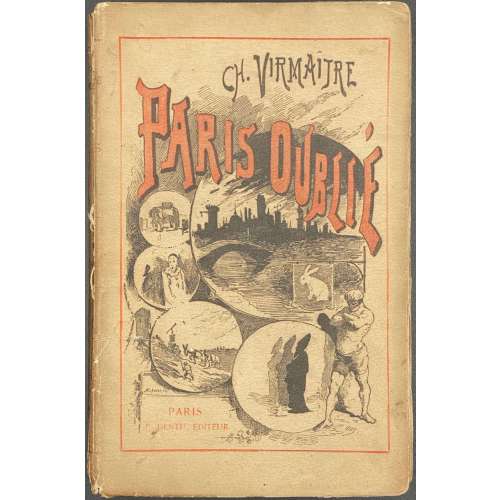 Cover: CH. VIRMAÎTRE | PARIS OUBLIÉ — PARIS | E. DENTU, ÉDITEUR || Title page: CHARLES VIRMAÎTRE | PARIS OUBLIÉ | {publisher’s device} | PARIS | E. DENTU, ÉDITEUR | LIBRAIRE DE LA SOCIÉTÉ DES GENTES DE LETTRES | PALAIS-ROYAL, 15-17-19, GALERIE D’ORLÉANS | 1886 | Tous droits réservés. || Pagination: publisher’s pictorial wrapper, ffl, [2] – t.p. / blank, 1-327 [328 blank], bfl, publisher’s advert. to back wrapper.
Cover: CH. VIRMAÎTRE | PARIS OUBLIÉ — PARIS | E. DENTU, ÉDITEUR || Title page: CHARLES VIRMAÎTRE | PARIS OUBLIÉ | {publisher’s device} | PARIS | E. DENTU, ÉDITEUR | LIBRAIRE DE LA SOCIÉTÉ DES GENTES DE LETTRES | PALAIS-ROYAL, 15-17-19, GALERIE D’ORLÉANS | 1886 | Tous droits réservés. || Pagination: publisher’s pictorial wrapper, ffl, [2] – t.p. / blank, 1-327 [328 blank], bfl, publisher’s advert. to back wrapper. -
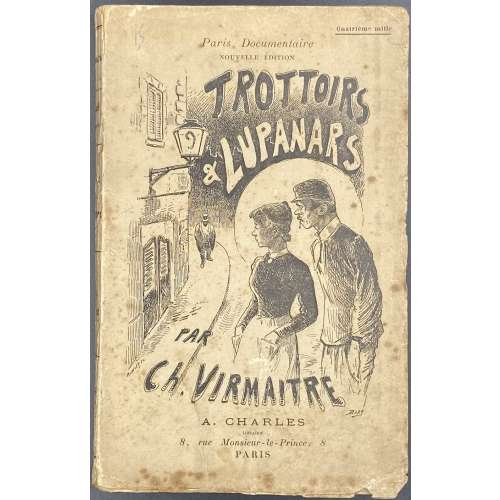 Front wrapper: Quatrième mille | Paris Documentaire | NOUVELLE ÉDITION | TROTTOIRS | ET | LUPANARS | PAR | Ch. VIRMAITRE | A. CHARLES | LIBRAIRE | 8, Rue Monsieur-le-Prince, 8 | PARIS || Title page: Ch. VIRMAITRE | PARIS DOCUMENTAIRE | (Mœurs) | TROTTOIRS | ET | LUPANARS | {fleuron} | A. CHARLES | LIBRAIRE | 8, Rue Monsieur-le-Prince, 8 | PARIS | 1897 || Collation: 18mo; Front pictorial wrapper, 2 ffls, π4, 118, 318, 518, 718, 918, 1118, 1318, 1514, back pictorial wrapper (portrait) Pagination: [1-7] 8-282 [6]. Binding: Publisher’s pictorial wrappers, lettering to spine. Charles Virmaître (French, 1835 – 1903).
Front wrapper: Quatrième mille | Paris Documentaire | NOUVELLE ÉDITION | TROTTOIRS | ET | LUPANARS | PAR | Ch. VIRMAITRE | A. CHARLES | LIBRAIRE | 8, Rue Monsieur-le-Prince, 8 | PARIS || Title page: Ch. VIRMAITRE | PARIS DOCUMENTAIRE | (Mœurs) | TROTTOIRS | ET | LUPANARS | {fleuron} | A. CHARLES | LIBRAIRE | 8, Rue Monsieur-le-Prince, 8 | PARIS | 1897 || Collation: 18mo; Front pictorial wrapper, 2 ffls, π4, 118, 318, 518, 718, 918, 1118, 1318, 1514, back pictorial wrapper (portrait) Pagination: [1-7] 8-282 [6]. Binding: Publisher’s pictorial wrappers, lettering to spine. Charles Virmaître (French, 1835 – 1903). -
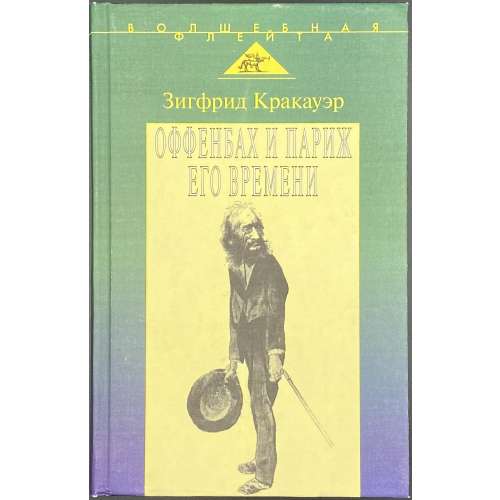 Hardcover, 21.5 x 13.5 cm, pictorial boards, [1-4] 5-412 [2] [2]. Print run 3,000. Translation from German of the original {Siegfried Krakauer. Jacques Offenbach und das Paris seiner Zeit. — Amsterdam: Allert de Lange, 1937} by Serafima Shlapoberskaya – Шлапоберская, Серафима Евгеньевна (Russian, 1921 – 2007).
Hardcover, 21.5 x 13.5 cm, pictorial boards, [1-4] 5-412 [2] [2]. Print run 3,000. Translation from German of the original {Siegfried Krakauer. Jacques Offenbach und das Paris seiner Zeit. — Amsterdam: Allert de Lange, 1937} by Serafima Shlapoberskaya – Шлапоберская, Серафима Евгеньевна (Russian, 1921 – 2007). -
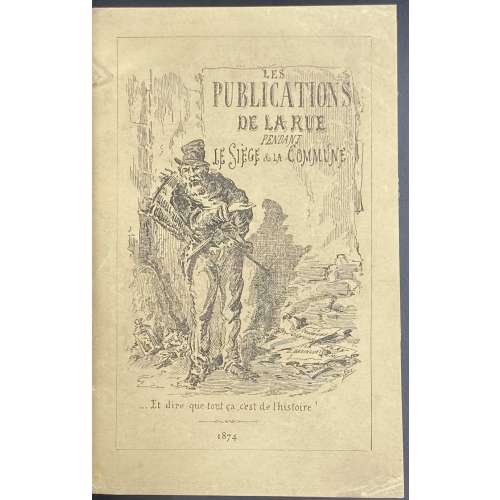 Convolute with three editions, dedicated to the Commune of Paris, 1871. (1) LES | Publications de la Rue | pendant | LE SIEGE ET LA COMMUNE | SATIRES — CANARDS — COMPLAINTES — CHANSONS | PLACARDS ET PAMPHLETS | BIBLIOGRAPHIE | PITTORESQUE ET ANECDOTIQUE | Par Firmin MAILLARD |{publisher’s device}| PARIS | AUGUSTE AUBRY, ÉDITEUR | 18, RUE SÉGUIER, 18 | 1874 || Pagination: ffl, original pictorial wrapper, [2] – blank / advert., [2] – h.t. / blank, [2] – h.t. / colophon imprim. PILLET FILS AINÉ, frontis. similar to front wrapper without '1874', [2] – t.p. / blank, [v] vi-xii, [1] 2-198, three blank leaves, back wrapper. (2) VILLE DE SAINT-DENIS | EXPOSITION D'ART & D'HISTOIRE | La Commune de Paris |18 Mars 1871 28 Mai | AVANT-PROPOS DE Lucien DESCAVES | de l’Académie Goncourt | PREFACE DE Jacques DORIOT | Député de la Seine, Maire de Saint-Denis | Du 17 Mars au 26 Mai 1935 | au Musée Municipal | 4, place de la Légion d’Honneur – Saint-Denis || Pagination: original pictorial wrapper in black and red, frontis., [2] - t.p. / blank, [2] – commité, v-xiii [xiv] 1-113 [114], 26 plates (13 leaves), blank back wrapper, spine tipped-in. (3) J. LEMONNYER | LES | JOURNAUX DE PARIS | PENDANT | LA COMMUNE | REVUE BIBLIOGRAPHIQUE COMPLETE | DE LA PRESSE PARISIENNE | du 19 Mars au 27 Mai | AVEC |{7 lines of text}| ET | UNE TABLE ALPHABÉTIQUE | DONNANT LE PRIX-COURANT DE CHAQUE COLLECTION | PARIS : J. LEMONNYER, Librarire | 73, Rue de Provence, 73 || Pagination: [2] - t.p. / blank, [2] – preface, [7] 8-94, green back wrapper w/advert., bfl. (lacks original front wrapper). Binding: Modern (20th century) red cloth, black label with gilt lettering to spine, matching marbled endpapers. Size: 18.5 x 13 cm; 12mo.
Convolute with three editions, dedicated to the Commune of Paris, 1871. (1) LES | Publications de la Rue | pendant | LE SIEGE ET LA COMMUNE | SATIRES — CANARDS — COMPLAINTES — CHANSONS | PLACARDS ET PAMPHLETS | BIBLIOGRAPHIE | PITTORESQUE ET ANECDOTIQUE | Par Firmin MAILLARD |{publisher’s device}| PARIS | AUGUSTE AUBRY, ÉDITEUR | 18, RUE SÉGUIER, 18 | 1874 || Pagination: ffl, original pictorial wrapper, [2] – blank / advert., [2] – h.t. / blank, [2] – h.t. / colophon imprim. PILLET FILS AINÉ, frontis. similar to front wrapper without '1874', [2] – t.p. / blank, [v] vi-xii, [1] 2-198, three blank leaves, back wrapper. (2) VILLE DE SAINT-DENIS | EXPOSITION D'ART & D'HISTOIRE | La Commune de Paris |18 Mars 1871 28 Mai | AVANT-PROPOS DE Lucien DESCAVES | de l’Académie Goncourt | PREFACE DE Jacques DORIOT | Député de la Seine, Maire de Saint-Denis | Du 17 Mars au 26 Mai 1935 | au Musée Municipal | 4, place de la Légion d’Honneur – Saint-Denis || Pagination: original pictorial wrapper in black and red, frontis., [2] - t.p. / blank, [2] – commité, v-xiii [xiv] 1-113 [114], 26 plates (13 leaves), blank back wrapper, spine tipped-in. (3) J. LEMONNYER | LES | JOURNAUX DE PARIS | PENDANT | LA COMMUNE | REVUE BIBLIOGRAPHIQUE COMPLETE | DE LA PRESSE PARISIENNE | du 19 Mars au 27 Mai | AVEC |{7 lines of text}| ET | UNE TABLE ALPHABÉTIQUE | DONNANT LE PRIX-COURANT DE CHAQUE COLLECTION | PARIS : J. LEMONNYER, Librarire | 73, Rue de Provence, 73 || Pagination: [2] - t.p. / blank, [2] – preface, [7] 8-94, green back wrapper w/advert., bfl. (lacks original front wrapper). Binding: Modern (20th century) red cloth, black label with gilt lettering to spine, matching marbled endpapers. Size: 18.5 x 13 cm; 12mo. -
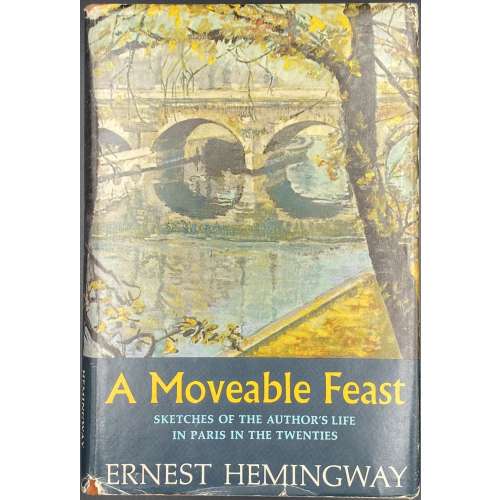 ERNEST HEMINGWAY | A Moveable Feast | {Citation} | CHARLES SCRIBNER'S SONS, | New York || Pagination: [12] – incl: advert., h.t., t.p., colophon, contents, preface, and note, [1, 2] - f.t. / blank, 3-211 [212]. Publisher’s cloth-backed stamped boards, original dust jacket. Ref.: Hanneman A31a.
ERNEST HEMINGWAY | A Moveable Feast | {Citation} | CHARLES SCRIBNER'S SONS, | New York || Pagination: [12] – incl: advert., h.t., t.p., colophon, contents, preface, and note, [1, 2] - f.t. / blank, 3-211 [212]. Publisher’s cloth-backed stamped boards, original dust jacket. Ref.: Hanneman A31a. -
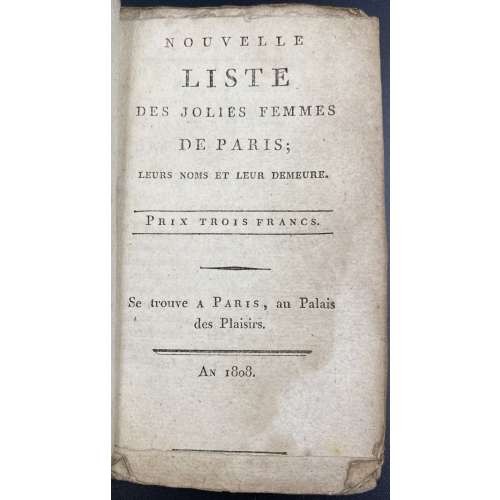 Title: NOUVELLE | LISTE | DES JOLIES FEMMES | DE PARIS ; | LEURS NOMS ET LEUR DEMEURE. | PRIX TROIS FRANCS. | Se trouve A Paris , au Palais des plaisirs. | — | An 1808. || Pagination : [1-6] 7-70 [2 blank] Collation : 9vo, [A]9 B-D9. Binding: Original blue wrappers, 15 x 9 cm. Ref: OCLC finds only one copy, at the British Library. The BnF has a work of the same title, with the same pagination, dated 1803. The stated publisher seems to be fictitious. Quaritch description: 12mo, pp. 70; a little dusty, a few spots and marks; a very good uncut copy in original blue/grey wrappers; somewhat worn and stained. Very rare guide to Parisian prostitutes providing an extraordinary snapshot of the state of prostitution in the city during the First French Empire. The anonymous compiler begins with a brief history of prostitution in the capital, and its regulation, under Charlemagne and Louis VIII, describes a brothel established by Joanna I of Naples at Avignon and discusses Pierre-Jean Grosley’s estimate of the number of prostitutes in London. He then provides his liste, divided into categories including ‘houses of the first order’, ‘bawdy houses’, ‘actresses’, ‘washerwomen’, and ‘procuresses’, giving the name of each prostitute, an indication of their age, and their physical attributes, character, and particular talents. Rosanne, for example, chez Madame l’Évêque at the Palais du Tribunat, offers ‘unspeakably voluptuous pleasures to the nether regions’; Honorine prefers women; Scholastique likes wine with her lovemaking; Nanette has a penchant for soldiers; Genevieve favours the priapic; Dorsay enjoys S&M, and Madame Laperriere promises rejuvenation to the elderly. One Ducroisy is poetically described as possessing ‘a tuft as black as a crow above two alabaster columns’, while Félicité has skin ‘soft and white, sprinkled with golden freckles, like gold in Maraschino liqueur’. The author hopes that his listed will bring business to the ladies and pleasure to their clients, beseeching both to look after their health so that his guide might ‘serve Love, not Asclepius’.
Title: NOUVELLE | LISTE | DES JOLIES FEMMES | DE PARIS ; | LEURS NOMS ET LEUR DEMEURE. | PRIX TROIS FRANCS. | Se trouve A Paris , au Palais des plaisirs. | — | An 1808. || Pagination : [1-6] 7-70 [2 blank] Collation : 9vo, [A]9 B-D9. Binding: Original blue wrappers, 15 x 9 cm. Ref: OCLC finds only one copy, at the British Library. The BnF has a work of the same title, with the same pagination, dated 1803. The stated publisher seems to be fictitious. Quaritch description: 12mo, pp. 70; a little dusty, a few spots and marks; a very good uncut copy in original blue/grey wrappers; somewhat worn and stained. Very rare guide to Parisian prostitutes providing an extraordinary snapshot of the state of prostitution in the city during the First French Empire. The anonymous compiler begins with a brief history of prostitution in the capital, and its regulation, under Charlemagne and Louis VIII, describes a brothel established by Joanna I of Naples at Avignon and discusses Pierre-Jean Grosley’s estimate of the number of prostitutes in London. He then provides his liste, divided into categories including ‘houses of the first order’, ‘bawdy houses’, ‘actresses’, ‘washerwomen’, and ‘procuresses’, giving the name of each prostitute, an indication of their age, and their physical attributes, character, and particular talents. Rosanne, for example, chez Madame l’Évêque at the Palais du Tribunat, offers ‘unspeakably voluptuous pleasures to the nether regions’; Honorine prefers women; Scholastique likes wine with her lovemaking; Nanette has a penchant for soldiers; Genevieve favours the priapic; Dorsay enjoys S&M, and Madame Laperriere promises rejuvenation to the elderly. One Ducroisy is poetically described as possessing ‘a tuft as black as a crow above two alabaster columns’, while Félicité has skin ‘soft and white, sprinkled with golden freckles, like gold in Maraschino liqueur’. The author hopes that his listed will bring business to the ladies and pleasure to their clients, beseeching both to look after their health so that his guide might ‘serve Love, not Asclepius’. -
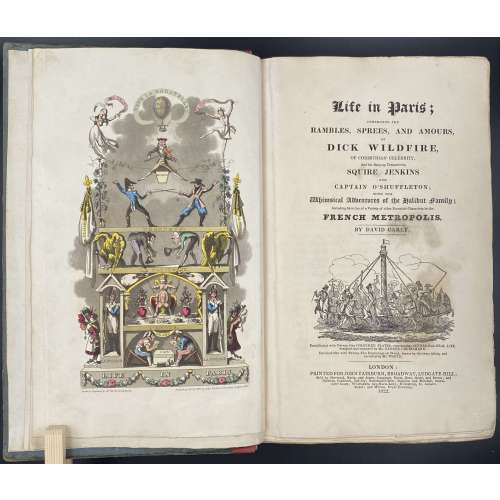
Title: Life in Paris ; | COMPRISING THE | RAMBLES, SPREES, AND AMOURS, | OF | DICK WILDFIRE, | OF CORINTHIAN CELEBRITY, | And his Bang-up Companions, SQUARE JENKINS | AND | CAPTAIN O’SHUFFLETON ; | WITH THE | Whimsical Adventures of the Halibut family ; | Including Sketches of a Variety of other Eccentric Characters in the | FRENCH METROPOLIS. | BY DAVID CAREY |[Vignette]| Embellished with Twenty-One COLOURED PLATES, representing SCENES from REAL LIFE, | designed and engraved by Mr. GEORGE CRUIKSHANK. | Enriched also with Twenty-Two Engravings on Wood, drawn by the same Artist, and | executed by Mr. WHITE. | LONDON : | PRINTED FOR JOHN FAIRBURN, BROADWAY, LUDGATE HILL; | Sold by Sherwood, Neely, and Jones ; Langman, Hurst, Rees, Orme, and Brown ; and | Baldwin, Craddoc, and Joy ; Paternoster-Row ; Simpkin and Marshall, Statio- | ners’ Court ; Whittakers Ave-Maria-Lane ; Humphrey, St. James’s | Street ; and Wilson, Royal Exchange. | 1822. ||
Edition: 1st edition in book form, 1st issue; large-paper copy bound from the parts in original blue paper boards, "most scarce" (Cohn).
Pagination: ffl, [i, ii] – h.t. ‘LIFE IN PARIS’ / ‘MARCHANT, Printer, Ingram-Court, London’, [2] – blank / Frontispiece (Ville la Bagatelle!!) hand-coloured, [iii, iv] – t.p. with vignette / blank, [v] vi-xxiv, [1] 2-489 [490 blank], [2] – 'TO THE BINDER' and 'Marchant, Printer, Ingram-Court, Fenchurch Street' "considered indispensable to a complete copy" (Cohn) / blank, bfl watermarked 1800; 21 hand-coloured aquatints and 22 wood-engraved text vignettes; cancelled leaves 143/4 and 335/6; pinholes from printing visible in most gatherings.
Collation: 4to; [a]-c4, B-Z4 Aa-Zz4 3A-3Q4 3R1 + [Ω]1
Binding: Original boards sometime re-backed with red paper, binder's end leaf watermarked 1800; red hard-grained morocco clamshell box.
Catalogue raisonné: Albert M. Cohn, 1924: № 109 p. 37/8; Abbey, J. R. (Life in England), 112; Tooley (Some English Books with Coloured Plates) 129; Hardie (English coloured books) 199.
Description of Shapero Rare Books, London: Of the copies that have come to auction since 1975 only one has been a large-paper copy in original boards. "The pictures are extremely spirited and true and are all the more wonderful in view of the fact that the artist’s continental experiences were limited to one day spent in Boulogne." (Hardie). In 1821, the journalist Pierce Egan published Life in London, an immediate success illustrated by the Cruikshank brothers, George and Robert. In order to capitalise on this success, another journalist, David Carey, decided to publish his own Life in Paris in monthly instalments (just like Life in London) and with a very similar frontispiece to the one that appears in Egan’s work; Life in Paris, however, was illustrated only by George Cruikshank. One of the earliest and most notable examples of the work of George Cruikshank, with fine, clean plates. -
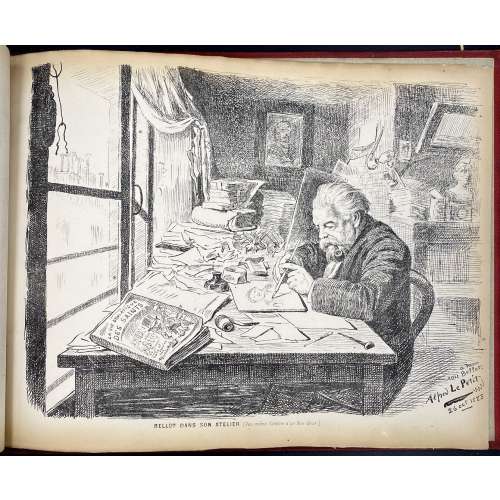 An album of the "Le Bon-Bock" dinners for the year 1884. Author, designer and publisher – Emile Bellot (French, 1831 – 1886), a Parisian artist and engraver. "Le Bon-Bock" was a monthly dinner of artists and men of letters, who gathered in Paris for good food, good company, and artistic performances, from 1875 to at least 1925. The story behind these gatherings as told by Emile Bellot, the founder, is this:
An album of the "Le Bon-Bock" dinners for the year 1884. Author, designer and publisher – Emile Bellot (French, 1831 – 1886), a Parisian artist and engraver. "Le Bon-Bock" was a monthly dinner of artists and men of letters, who gathered in Paris for good food, good company, and artistic performances, from 1875 to at least 1925. The story behind these gatherings as told by Emile Bellot, the founder, is this:In February 1875, Pierre Cottin1 came to me and said: 'I discovered a poet and tragedian of immense talent and who interprets the poems of the Great Victor Hugo in an astonishing way. Monsieur Gambini. I promised him that I would make it heard by an audience of artists and men of letters. I am counting on you who have many connections to keep my promise to him'. I gathered about 25 of my friends and acquaintances in a picnic dinner which took place at a restaurant 'Krauteimer' on the rue Rochechouart in Montmartre. They heard from Mr Gambini first, then my friends Étienne Carjat2, J. Gros3, Adrien Dézamy4, etc. performed. These gentlemen completed the evening so brilliantly that it was unanimously decided that we would start a similar dinner every month. Poets, musicians, men of letters, singers would be invited to this dinner. I was in charge of the organization of this little party and as it was the dream of my life to bring together old comrades, I was careful not to refuse and I pursued this good idea. Cottin and René Tener5 were kind enough to help me in this joyous task and especially my old friend Carjat. The following March began our 1st monthly dinner.
The name "Le Bon-Bock" means "The Good Bock", whilst Bock is a kind of beer, a dark, malty, lightly hopped ale. The dinner was named "Le Bon-Bock" in honour of the Éduard Manet painting (1873), a famous portrait of Emile Bellot, called "Le Bon-Bock".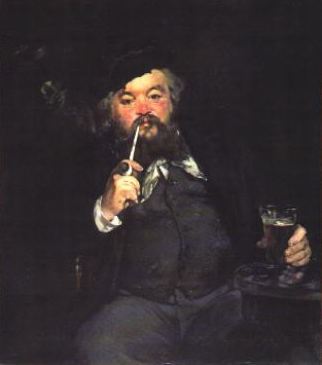 The invitations to the dinner were also produced by the artists and looked like this one by Alexandre Ferdinandus (October 3, 1883).
The invitations to the dinner were also produced by the artists and looked like this one by Alexandre Ferdinandus (October 3, 1883).
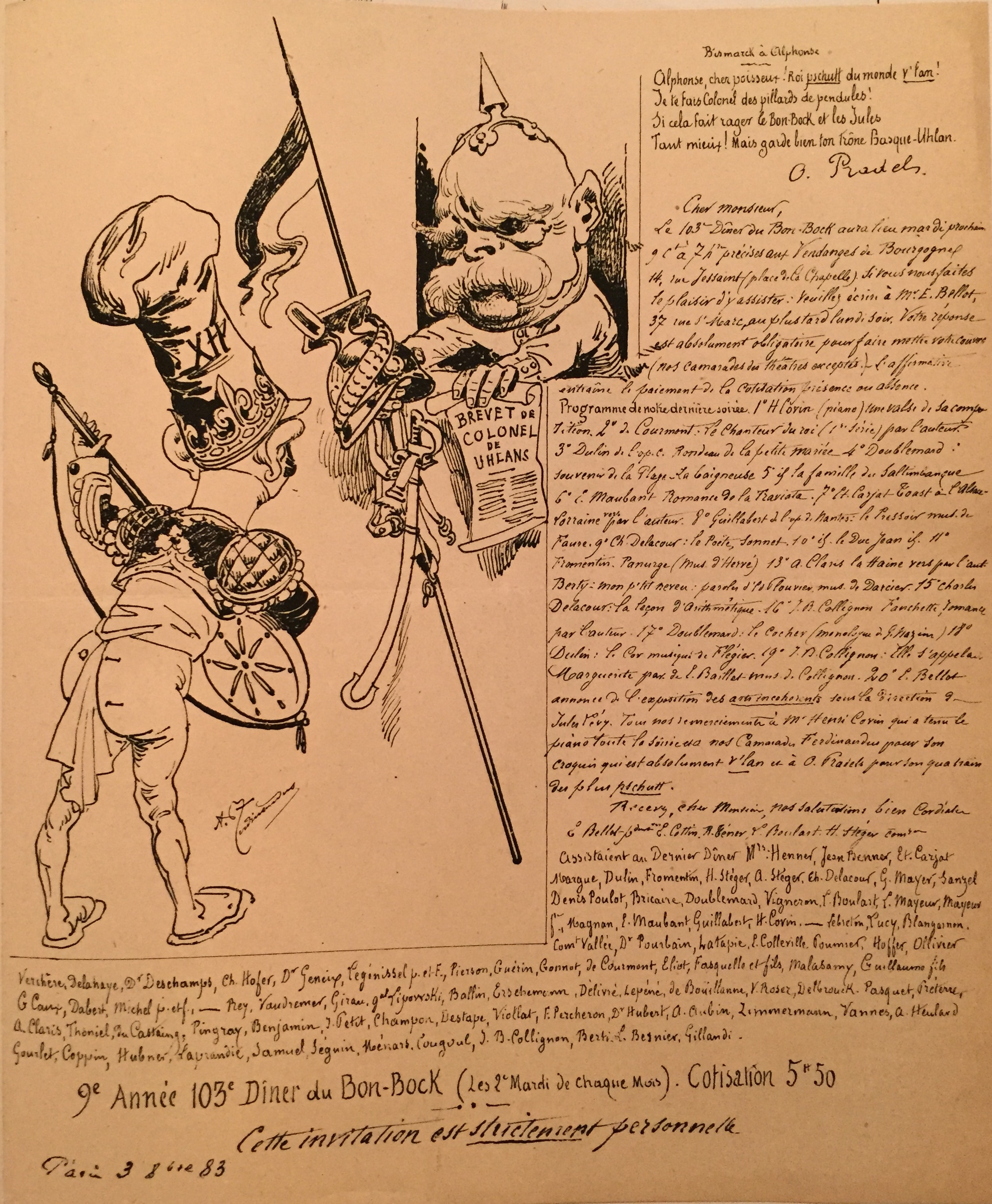 Besides this sketch of the Parisian social and artistic life at the end of the 19th century, the provenance of the album in our collection generates additional interest. The ink stamp to the front flyleaf reads: "Docteur Henry Uzan, 29 Avenue Perrichont, Paris XVI".
Doctor Henry Uzan was Jewish. He was arrested by the Pétain police on October 1, 1941, and interned in Drancy. With the few means at his disposal, he undertook to treat the sick whom he then saw leaving, week after week, towards their terrible destiny in the extermination camps. In October 1943 doctor Uzan was deported to the island of Alderney. After the Normandy Landing of June 6, 1944, Nazis evacuated the island detainees and transfer them to the Neuengamme camp, via northern France and Belgium. During the transfer, doctor Uzan managed to escape from the train on the night of September 3 to 4 around Dixmude in Flanders. He was taken in by the Belgian Resistance, which he joined before being repatriated to France.
In France, he continued working as a physician and was one of the founders of Association des internés et déportés politiques (AIDP). In 1945, together with his friends, the doctor designed the symbol for the Fédération nationale des déportés et internés résistants et patriotes:
Besides this sketch of the Parisian social and artistic life at the end of the 19th century, the provenance of the album in our collection generates additional interest. The ink stamp to the front flyleaf reads: "Docteur Henry Uzan, 29 Avenue Perrichont, Paris XVI".
Doctor Henry Uzan was Jewish. He was arrested by the Pétain police on October 1, 1941, and interned in Drancy. With the few means at his disposal, he undertook to treat the sick whom he then saw leaving, week after week, towards their terrible destiny in the extermination camps. In October 1943 doctor Uzan was deported to the island of Alderney. After the Normandy Landing of June 6, 1944, Nazis evacuated the island detainees and transfer them to the Neuengamme camp, via northern France and Belgium. During the transfer, doctor Uzan managed to escape from the train on the night of September 3 to 4 around Dixmude in Flanders. He was taken in by the Belgian Resistance, which he joined before being repatriated to France.
In France, he continued working as a physician and was one of the founders of Association des internés et déportés politiques (AIDP). In 1945, together with his friends, the doctor designed the symbol for the Fédération nationale des déportés et internés résistants et patriotes:
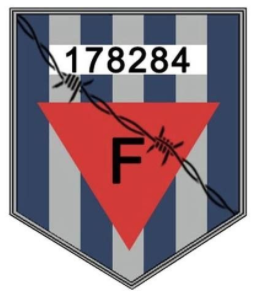 The story behind the number on the emblem (178284) is fascinating but it is out of the scope of this material.
The story behind the number on the emblem (178284) is fascinating but it is out of the scope of this material.
1. Pierre Cottin (French, 1823 – c. 1887) – Engraver, mezzotinter, genre and landscape painter; born in Chappelle-Saint-Denis (near Paris), a pupil of Jazet. Exhibited at the Salon from 1845, also in London from 1876 to 1879.↩ 2. Étienne Carjat (French, 1828 – 1906) – Journalist, caricaturist and photographer. ↩ 3. Jean Baptiste Louis Gros (French, 1793 – 1870) – Painter. ↩ 4. Adrien Dézamy (French, 1844 – 1891) – Writer, poet, general secretary of the Théâtre des Bouffes in Paris. ↩ 5. Rene Tener (French, 1846 – 1925) – Painter. ↩ Sources:Auguste Lepage. Les dîners artistiques et littéraires de Paris / Bibliothèque des Deux mondes (2e éd.) – Paris: Frinzine, Klein et Cie., 1884. [Accession № LIB-2606.2021 in this collection]
-
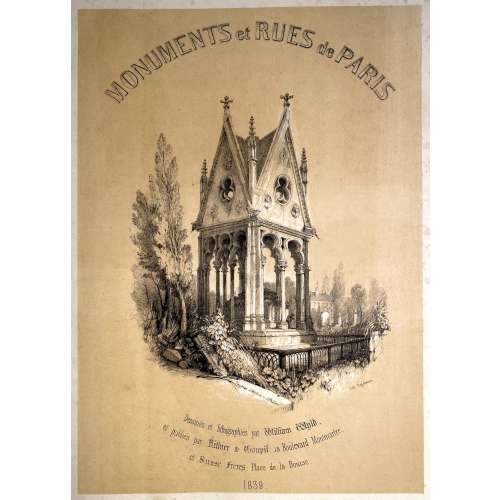 Pictorial album 55.5 x 41.0 cm, publisher’s quarter sheepskin over cloth, upper cover and flat spine lettered in gilt. Title: MONUMENTS et RUES de PARIS | Dessinés et lithographiés par William Wyld, | et publiés par Rittner & Goupil, 15 Boulevard Montmartre, | et Susse Frères, Place de la Bourse. | 1839. Collation: Title plate + 20 plates numbered from 1 to 20, printed by Godefroy Engelmann (French, 1788 – 1839) in tone lithography after drawings by William Wyld (British, 1806 – 1889). Published in Paris by Rittner & Goupil and Susse Frères in 1839. Plates: 54.8 x 39.8 cm. Contents:
Pictorial album 55.5 x 41.0 cm, publisher’s quarter sheepskin over cloth, upper cover and flat spine lettered in gilt. Title: MONUMENTS et RUES de PARIS | Dessinés et lithographiés par William Wyld, | et publiés par Rittner & Goupil, 15 Boulevard Montmartre, | et Susse Frères, Place de la Bourse. | 1839. Collation: Title plate + 20 plates numbered from 1 to 20, printed by Godefroy Engelmann (French, 1788 – 1839) in tone lithography after drawings by William Wyld (British, 1806 – 1889). Published in Paris by Rittner & Goupil and Susse Frères in 1839. Plates: 54.8 x 39.8 cm. Contents:Title page: Tombeau d'Heloïse et d'Abélard
- Le Pont Neuf
- L'église de la Madeleine
- La Porte St. Martin
- Palais des Tuileries
- Pont des Saints-Pères
- Hôtel de Ville
- Marché des Innocents
- Palais Royal
- Boulevard des Italiens
- Rue de la Paix
- Bourse et Tribunal de Commerce
- Porte St. Denis
- Pont Royal
- Place de la Concorde
- Paris from Père Lachaise
- Notre-Dame
- Jardin des Tuileries with Arc de Triomphe in the Distance
- Panthéon
- Chambre des députés
- Arc de Triomphe de l'Étoile
-
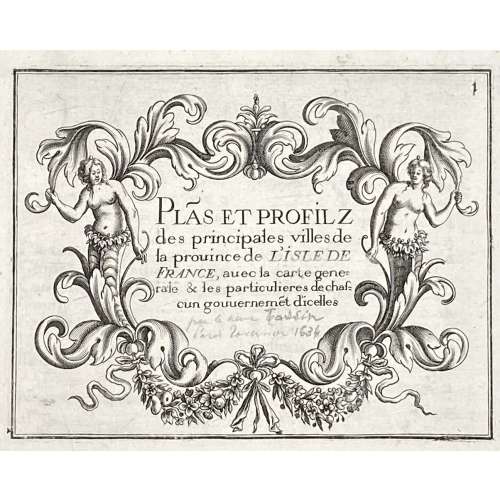 Title page: Text engraved within a vignette with two naked female torses in garlands: Plãs et profilz | des principales villes de | la prouince de L'ISLE DE | FRANCE, auec la carte gene~ | rale & les particulieres de chaf~ | cun gouuernement d'icelles. Below handwritten pencil inscription by a previous owner: "par ... Tassin ... 1634". Size: 17.6 x 23.7 cm, Binding: Italian style, green half-vellum, burgundy morocco title label with vertical gilt lettering to spine, peacock marbled boards. Pagination: Two blank flyleaves in the front and two in the back; 18 numbered engraved plates, including:
Title page: Text engraved within a vignette with two naked female torses in garlands: Plãs et profilz | des principales villes de | la prouince de L'ISLE DE | FRANCE, auec la carte gene~ | rale & les particulieres de chaf~ | cun gouuernement d'icelles. Below handwritten pencil inscription by a previous owner: "par ... Tassin ... 1634". Size: 17.6 x 23.7 cm, Binding: Italian style, green half-vellum, burgundy morocco title label with vertical gilt lettering to spine, peacock marbled boards. Pagination: Two blank flyleaves in the front and two in the back; 18 numbered engraved plates, including:- Title page
- Table of Contents
- Normandie
- Environs de Paris
- Folding map of Paris – a simplified copy of Mathieu Merian's 1615 perspective plan, with minor updates, notably on the current housing estate of Ile Saint-Louis.
- Paris
- Gouvernment de Soissons
- Soissons
- Gouvernment de Beauvais
- Beauvais
- Gouvernment de Compiègne
- Compiègne
- Gouvernment de Noyon
- Noyon
- Gouvernment de Coussi
- Coussi
- Gouvernment de Senlis
- Senlis


